Input interpretation

Na_2CO_3 soda ash + NH_4Cl ammonium chloride ⟶ H_2O water + CO_2 carbon dioxide + NaCl sodium chloride + NH_3 ammonia
Balanced equation
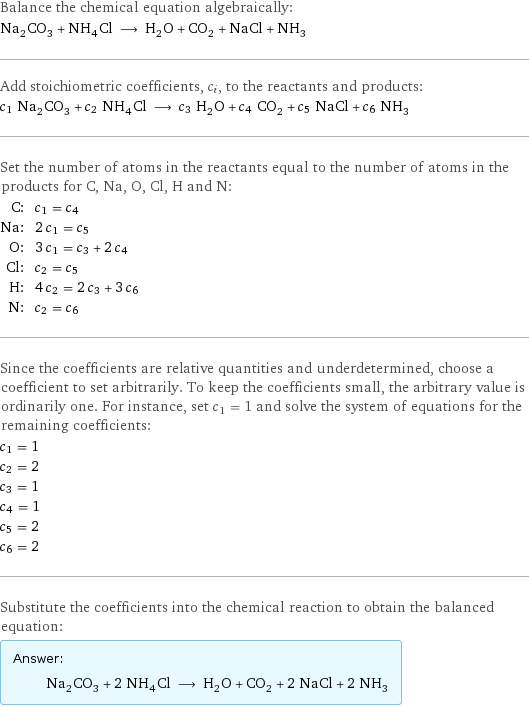
Balance the chemical equation algebraically: Na_2CO_3 + NH_4Cl ⟶ H_2O + CO_2 + NaCl + NH_3 Add stoichiometric coefficients, c_i, to the reactants and products: c_1 Na_2CO_3 + c_2 NH_4Cl ⟶ c_3 H_2O + c_4 CO_2 + c_5 NaCl + c_6 NH_3 Set the number of atoms in the reactants equal to the number of atoms in the products for C, Na, O, Cl, H and N: C: | c_1 = c_4 Na: | 2 c_1 = c_5 O: | 3 c_1 = c_3 + 2 c_4 Cl: | c_2 = c_5 H: | 4 c_2 = 2 c_3 + 3 c_6 N: | c_2 = c_6 Since the coefficients are relative quantities and underdetermined, choose a coefficient to set arbitrarily. To keep the coefficients small, the arbitrary value is ordinarily one. For instance, set c_1 = 1 and solve the system of equations for the remaining coefficients: c_1 = 1 c_2 = 2 c_3 = 1 c_4 = 1 c_5 = 2 c_6 = 2 Substitute the coefficients into the chemical reaction to obtain the balanced equation: Answer: | | Na_2CO_3 + 2 NH_4Cl ⟶ H_2O + CO_2 + 2 NaCl + 2 NH_3
Structures
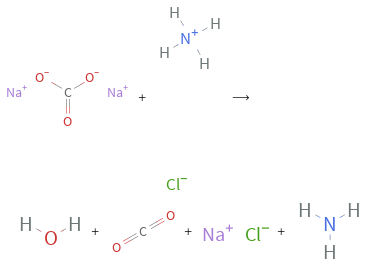
+ ⟶ + + +
Names

soda ash + ammonium chloride ⟶ water + carbon dioxide + sodium chloride + ammonia
Reaction thermodynamics
Enthalpy
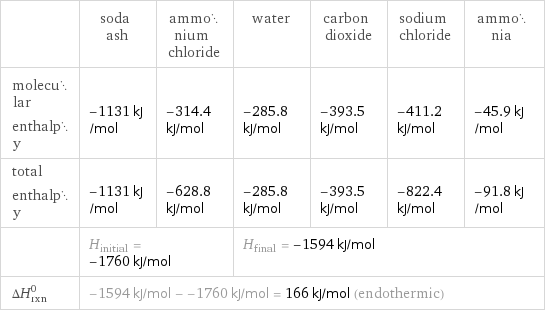
| soda ash | ammonium chloride | water | carbon dioxide | sodium chloride | ammonia molecular enthalpy | -1131 kJ/mol | -314.4 kJ/mol | -285.8 kJ/mol | -393.5 kJ/mol | -411.2 kJ/mol | -45.9 kJ/mol total enthalpy | -1131 kJ/mol | -628.8 kJ/mol | -285.8 kJ/mol | -393.5 kJ/mol | -822.4 kJ/mol | -91.8 kJ/mol | H_initial = -1760 kJ/mol | | H_final = -1594 kJ/mol | | | ΔH_rxn^0 | -1594 kJ/mol - -1760 kJ/mol = 166 kJ/mol (endothermic) | | | | |
Gibbs free energy
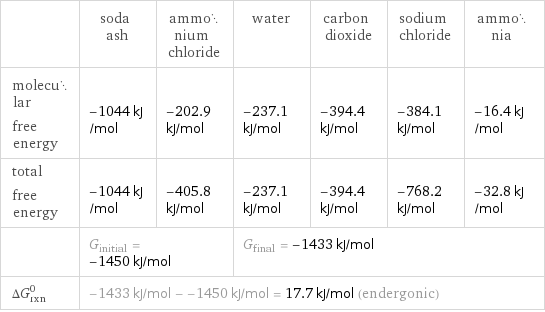
| soda ash | ammonium chloride | water | carbon dioxide | sodium chloride | ammonia molecular free energy | -1044 kJ/mol | -202.9 kJ/mol | -237.1 kJ/mol | -394.4 kJ/mol | -384.1 kJ/mol | -16.4 kJ/mol total free energy | -1044 kJ/mol | -405.8 kJ/mol | -237.1 kJ/mol | -394.4 kJ/mol | -768.2 kJ/mol | -32.8 kJ/mol | G_initial = -1450 kJ/mol | | G_final = -1433 kJ/mol | | | ΔG_rxn^0 | -1433 kJ/mol - -1450 kJ/mol = 17.7 kJ/mol (endergonic) | | | | |
Entropy
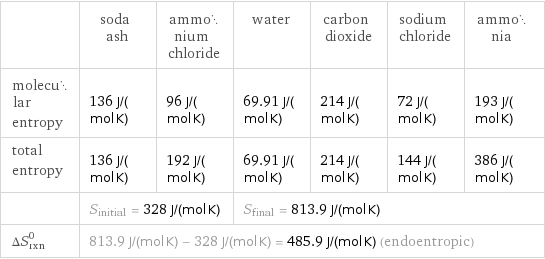
| soda ash | ammonium chloride | water | carbon dioxide | sodium chloride | ammonia molecular entropy | 136 J/(mol K) | 96 J/(mol K) | 69.91 J/(mol K) | 214 J/(mol K) | 72 J/(mol K) | 193 J/(mol K) total entropy | 136 J/(mol K) | 192 J/(mol K) | 69.91 J/(mol K) | 214 J/(mol K) | 144 J/(mol K) | 386 J/(mol K) | S_initial = 328 J/(mol K) | | S_final = 813.9 J/(mol K) | | | ΔS_rxn^0 | 813.9 J/(mol K) - 328 J/(mol K) = 485.9 J/(mol K) (endoentropic) | | | | |
Equilibrium constant
![Construct the equilibrium constant, K, expression for: Na_2CO_3 + NH_4Cl ⟶ H_2O + CO_2 + NaCl + NH_3 Plan: • Balance the chemical equation. • Determine the stoichiometric numbers. • Assemble the activity expression for each chemical species. • Use the activity expressions to build the equilibrium constant expression. Write the balanced chemical equation: Na_2CO_3 + 2 NH_4Cl ⟶ H_2O + CO_2 + 2 NaCl + 2 NH_3 Assign stoichiometric numbers, ν_i, using the stoichiometric coefficients, c_i, from the balanced chemical equation in the following manner: ν_i = -c_i for reactants and ν_i = c_i for products: chemical species | c_i | ν_i Na_2CO_3 | 1 | -1 NH_4Cl | 2 | -2 H_2O | 1 | 1 CO_2 | 1 | 1 NaCl | 2 | 2 NH_3 | 2 | 2 Assemble the activity expressions accounting for the state of matter and ν_i: chemical species | c_i | ν_i | activity expression Na_2CO_3 | 1 | -1 | ([Na2CO3])^(-1) NH_4Cl | 2 | -2 | ([NH4Cl])^(-2) H_2O | 1 | 1 | [H2O] CO_2 | 1 | 1 | [CO2] NaCl | 2 | 2 | ([NaCl])^2 NH_3 | 2 | 2 | ([NH3])^2 The equilibrium constant symbol in the concentration basis is: K_c Mulitply the activity expressions to arrive at the K_c expression: Answer: | | K_c = ([Na2CO3])^(-1) ([NH4Cl])^(-2) [H2O] [CO2] ([NaCl])^2 ([NH3])^2 = ([H2O] [CO2] ([NaCl])^2 ([NH3])^2)/([Na2CO3] ([NH4Cl])^2)](../image_source/c7f96331a2f0d4321e05ae90b4d9f3c6.png)
Construct the equilibrium constant, K, expression for: Na_2CO_3 + NH_4Cl ⟶ H_2O + CO_2 + NaCl + NH_3 Plan: • Balance the chemical equation. • Determine the stoichiometric numbers. • Assemble the activity expression for each chemical species. • Use the activity expressions to build the equilibrium constant expression. Write the balanced chemical equation: Na_2CO_3 + 2 NH_4Cl ⟶ H_2O + CO_2 + 2 NaCl + 2 NH_3 Assign stoichiometric numbers, ν_i, using the stoichiometric coefficients, c_i, from the balanced chemical equation in the following manner: ν_i = -c_i for reactants and ν_i = c_i for products: chemical species | c_i | ν_i Na_2CO_3 | 1 | -1 NH_4Cl | 2 | -2 H_2O | 1 | 1 CO_2 | 1 | 1 NaCl | 2 | 2 NH_3 | 2 | 2 Assemble the activity expressions accounting for the state of matter and ν_i: chemical species | c_i | ν_i | activity expression Na_2CO_3 | 1 | -1 | ([Na2CO3])^(-1) NH_4Cl | 2 | -2 | ([NH4Cl])^(-2) H_2O | 1 | 1 | [H2O] CO_2 | 1 | 1 | [CO2] NaCl | 2 | 2 | ([NaCl])^2 NH_3 | 2 | 2 | ([NH3])^2 The equilibrium constant symbol in the concentration basis is: K_c Mulitply the activity expressions to arrive at the K_c expression: Answer: | | K_c = ([Na2CO3])^(-1) ([NH4Cl])^(-2) [H2O] [CO2] ([NaCl])^2 ([NH3])^2 = ([H2O] [CO2] ([NaCl])^2 ([NH3])^2)/([Na2CO3] ([NH4Cl])^2)
Rate of reaction
![Construct the rate of reaction expression for: Na_2CO_3 + NH_4Cl ⟶ H_2O + CO_2 + NaCl + NH_3 Plan: • Balance the chemical equation. • Determine the stoichiometric numbers. • Assemble the rate term for each chemical species. • Write the rate of reaction expression. Write the balanced chemical equation: Na_2CO_3 + 2 NH_4Cl ⟶ H_2O + CO_2 + 2 NaCl + 2 NH_3 Assign stoichiometric numbers, ν_i, using the stoichiometric coefficients, c_i, from the balanced chemical equation in the following manner: ν_i = -c_i for reactants and ν_i = c_i for products: chemical species | c_i | ν_i Na_2CO_3 | 1 | -1 NH_4Cl | 2 | -2 H_2O | 1 | 1 CO_2 | 1 | 1 NaCl | 2 | 2 NH_3 | 2 | 2 The rate term for each chemical species, B_i, is 1/ν_i(Δ[B_i])/(Δt) where [B_i] is the amount concentration and t is time: chemical species | c_i | ν_i | rate term Na_2CO_3 | 1 | -1 | -(Δ[Na2CO3])/(Δt) NH_4Cl | 2 | -2 | -1/2 (Δ[NH4Cl])/(Δt) H_2O | 1 | 1 | (Δ[H2O])/(Δt) CO_2 | 1 | 1 | (Δ[CO2])/(Δt) NaCl | 2 | 2 | 1/2 (Δ[NaCl])/(Δt) NH_3 | 2 | 2 | 1/2 (Δ[NH3])/(Δt) (for infinitesimal rate of change, replace Δ with d) Set the rate terms equal to each other to arrive at the rate expression: Answer: | | rate = -(Δ[Na2CO3])/(Δt) = -1/2 (Δ[NH4Cl])/(Δt) = (Δ[H2O])/(Δt) = (Δ[CO2])/(Δt) = 1/2 (Δ[NaCl])/(Δt) = 1/2 (Δ[NH3])/(Δt) (assuming constant volume and no accumulation of intermediates or side products)](../image_source/191aba85f12110abb38a5e3d7598a4b1.png)
Construct the rate of reaction expression for: Na_2CO_3 + NH_4Cl ⟶ H_2O + CO_2 + NaCl + NH_3 Plan: • Balance the chemical equation. • Determine the stoichiometric numbers. • Assemble the rate term for each chemical species. • Write the rate of reaction expression. Write the balanced chemical equation: Na_2CO_3 + 2 NH_4Cl ⟶ H_2O + CO_2 + 2 NaCl + 2 NH_3 Assign stoichiometric numbers, ν_i, using the stoichiometric coefficients, c_i, from the balanced chemical equation in the following manner: ν_i = -c_i for reactants and ν_i = c_i for products: chemical species | c_i | ν_i Na_2CO_3 | 1 | -1 NH_4Cl | 2 | -2 H_2O | 1 | 1 CO_2 | 1 | 1 NaCl | 2 | 2 NH_3 | 2 | 2 The rate term for each chemical species, B_i, is 1/ν_i(Δ[B_i])/(Δt) where [B_i] is the amount concentration and t is time: chemical species | c_i | ν_i | rate term Na_2CO_3 | 1 | -1 | -(Δ[Na2CO3])/(Δt) NH_4Cl | 2 | -2 | -1/2 (Δ[NH4Cl])/(Δt) H_2O | 1 | 1 | (Δ[H2O])/(Δt) CO_2 | 1 | 1 | (Δ[CO2])/(Δt) NaCl | 2 | 2 | 1/2 (Δ[NaCl])/(Δt) NH_3 | 2 | 2 | 1/2 (Δ[NH3])/(Δt) (for infinitesimal rate of change, replace Δ with d) Set the rate terms equal to each other to arrive at the rate expression: Answer: | | rate = -(Δ[Na2CO3])/(Δt) = -1/2 (Δ[NH4Cl])/(Δt) = (Δ[H2O])/(Δt) = (Δ[CO2])/(Δt) = 1/2 (Δ[NaCl])/(Δt) = 1/2 (Δ[NH3])/(Δt) (assuming constant volume and no accumulation of intermediates or side products)
Chemical names and formulas
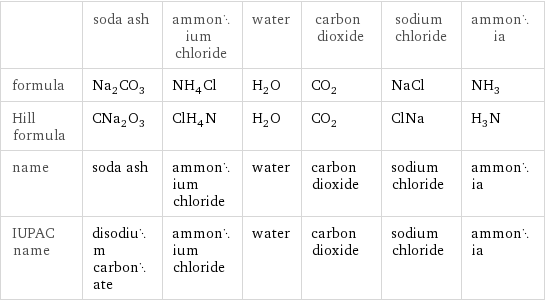
| soda ash | ammonium chloride | water | carbon dioxide | sodium chloride | ammonia formula | Na_2CO_3 | NH_4Cl | H_2O | CO_2 | NaCl | NH_3 Hill formula | CNa_2O_3 | ClH_4N | H_2O | CO_2 | ClNa | H_3N name | soda ash | ammonium chloride | water | carbon dioxide | sodium chloride | ammonia IUPAC name | disodium carbonate | ammonium chloride | water | carbon dioxide | sodium chloride | ammonia